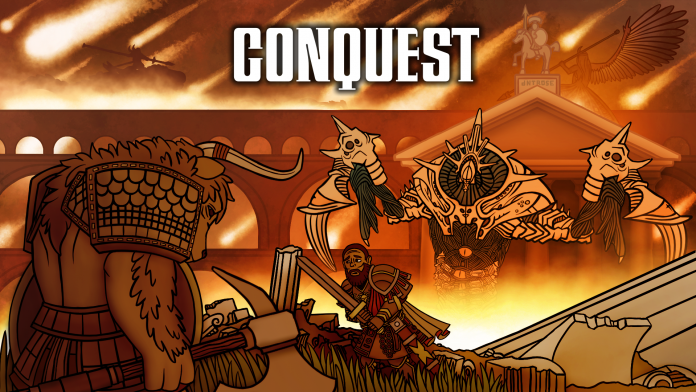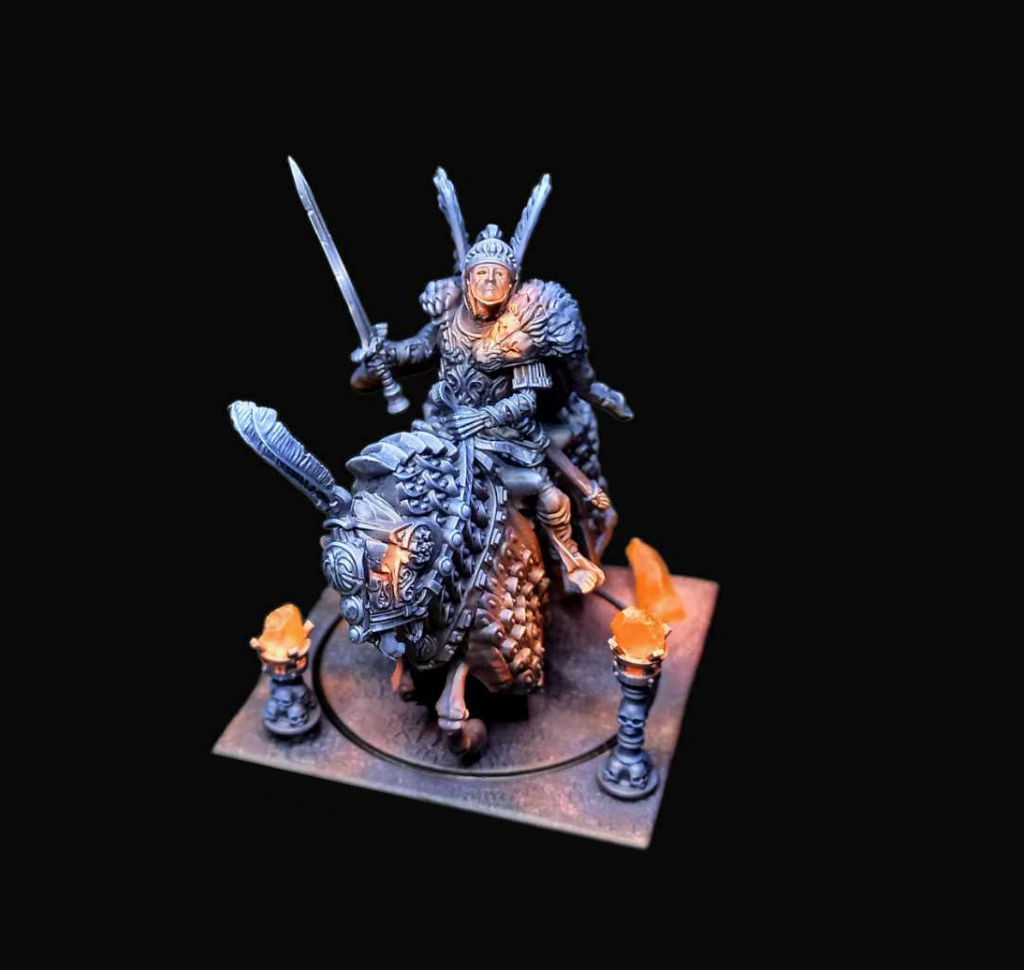Updated 5 November 2024
“A common misconception amongst modern historians and their students is that the title of Dominion refers to the Dominion of Man. It most certainly does not. The original inhabitants referred instead to the Dominion of Hazlia, the Pantokrator, God of Mankind. And with his Fall the Dominion ended – but did not die…”
The Old Dominion are Conquest’s Undead faction, modelled aesthetically on the Eastern Roman and Byzantine empires. No mere shambling zombie hordes, the animate vessels of the Old Dominion are an elite, durable force with an emphasis on resilient infantry supported by strange and macabre constructs of the priesthood.
Although Old Dominion have strong tools for contesting the early game, playing the Old Dominion is nevertheless an exercise in patience. This is not an army of sweeping manoeuvre or cataclysmic long-ranged fire; the Dominion moves carefully but inexorably, weathering the early game, building its strength, and crushing their opposition in the late game. As an Old Dominion player, time is on your side, and your force is resilient enough to make the most of it.
Strengths:
- Highly durable, as they ignore resolve checks
- Powerful characters, both in terms of offensive output and ability to support units
- Some of the best magic in the game
- Gets stronger as the game progresses
- Generally well balanced roster with many ways to play
Weaknesses:
- Generally expensive, smaller units and lower activation counts
- Limited mobility – not slow, but not highly mobile.
- Vulnerable to enemy ranged attacks and other attacks balanced around not doing resolve damage (which are comparatively efficient against Old Dominion)
- Weak early game, as your army needs to take casualties to power up
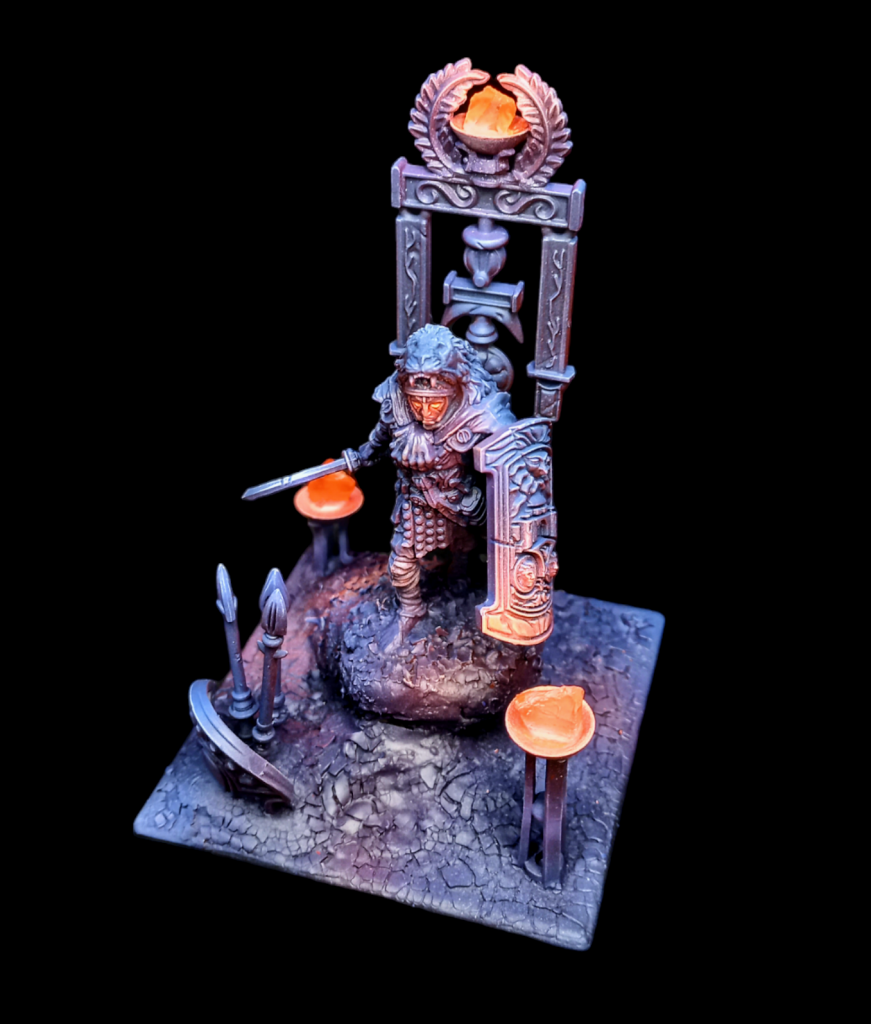
CAVEAT PANTOKRATOR – OLD DOMINION IN CASUAL PLAY
For new players looking to get into Conquest with the Old Dominion, a quick advisory needs to be issued about Old Dominion in casual play. Unless you are jumping into an experienced community (and maybe even then), your faction is likely to be complained about. The nature of how Old Dominion plays, with rubber-banding mechanics and late-game strength, give them exaggerated strength in casual play. To play effectively against Old Dominion, the opposing player needs to be aggressive and decisive in the early game (when Old Dominion is weakest) and establish a lead that the Old Dominion can’t steamroll over in the late game. New and casual players are much less likely to either know how to, or want, to go for the throat like this in the first half of the game, and once they forfeit their early-game advantages the mechanical late-game strength of Old Dominion will bury them. In short, Old Dominion just isn’t a faction that you can easily play casually against.
If you’re an aspiring Old Dominion player, there isn’t much you can do about this other than to be a good opponent. If you’re playing Old Dominion, be aware that you will often feel behind early game and swing back late game. This means that you should never, under any circumstances, spend the first half of the game complaining about your faction strength, or dice, etc. Nothing is worse than playing against someone who spends the first half of the game complaining and the second half winning.
If you’re interested in learning how to play against Old Dominion, or need to give your opponents some tips, we have an article about how to fight Old Dominion that might be of use.
ARMY ABILITIES
The Old Dominion are characterised by three notable special rules, the Animate Vessel and Memories of Old rules shared by (almost) all their units, and the Dark Power army-wide special rule.
Animate Vessel
Animate Vessels are the undead animated by Hazlia’s power. This rule prevents your troops from performing the inspire action (which coupled with generally low clash values makes it hard for Old Dominion to land a lot of hits in melee) but makes all units with the rule Terrifying (1).
Additionally, Animate Vessels have a resolve characteristic of ‘-‘ and always pass all resolve characteristic tests. This is the source of the Dominion’s resilience – even for a regiment with huge resolve and rules like fearless, a sufficiently unlucky resolve roll can still turn a bad enemy attack into a catastrophic one. Not so for the Old Dominion; your animate vessels will never take damage from resolve, meaning they’ll never get unlucky and take a sudden and unexpected damage spike to a series of resolve failures.
Memories of Old
All Animate Vessels pair that rule with their Memories of Old. A unit’s memories will provide some boost that augments the unit (like Bastion, Cleave, Brutal Impact, additional Impact hits, etc) but which are initially only available by spending one of the unit’s actions. As you accumulate Dark Power, these will first become a draw event (instead of an action), and then later be useable as both a draw event and an action. Only a small number of regiments will try to stack their Memories this way, but it can be powerful when they do.
This early requirement to spend precious actions to access rules like Bastion or extra offensive power is part of what constrains your early game. The value of their memories will vary from unit to unit; for some, it’s a nice boost, but for others it’s an essential part of their role, meaning they don’t come fully online until you’ve generated enough Dark Power. Which brings us to…
Dark Power
At the start of every turn, and whenever one of your stands with the Animate Vessel rule dies, you add a point to the Dark Power pool. By default, there’s only one power pool in any given army (with the exception being an army led by a Fallen Divinity – see below), and as power gets added to the pool, your army becomes more powerful.
Once you reach the second tier (typically at nine tokens) your Memories of Old unlock as draw events, and at the third tier (at eighteen tokens – not generally reached until late into the game) your whole army becomes inspired without having to perform the inspire action (which animate vessels cannot do anyway). Certain commanders also unlock a fourth tier, which makes your army inflict greater resolve damage on enemies.
This mechanic is what makes the Old Dominion such a late-game powerhouse. Although their troops start out making the trade-offs of cost, speed and lethality in exchange for their impressive durability, as the game passes those weaknesses begin to fall away. This means, almost unique amongst Conquest factions, the Old Dominon has an in-built rubber band mechanic, which helps you come back if you fall behind. The more casualties you sustain, the more dangerous your remaining troops become. Managing this, and keeping a handle on the feeling that you’re behind and therefore losing (you might not be!) is key to playing the Dominion. Keep your eye on the late-game, and remember – time is on your side.
Putting it together – Dark Power in practice
With the basic principles of the Old Dominion’s special rules established, it’s worth taking a moment to discuss how to make best use of these abilities.
How you’ll interact with Dark Power is something you need to think about at the list construction step. Then, once you’re playing a game, you’ll want to put your plan into action (and deal with the many curveballs your opponent attempts to throw your way).
Here are some basic things to consider when building a list for the Old Dominion:
How much do you need Dark Power?
Not all lists need the same amount of Dark Power at the same time. Some units can get by without access to their Memories of Old, or don’t have Memories of Old strong enough to justify chasing higher tiers quickly (for example, Athanatoi), whereas other units need access to higher tiers to unlock their full effectiveness.
An army with Kataphraktoi, for example, needs a way to have their memories of old available as a draw event before the Kataphraktoi make any charges, so needs access to Tier 2 of Dark Power early, or some way to let the Kataphraktoi treat their dark power as a tier higher. On the other hand, an army built around Legionnaires, Athanatoi or most of our Heavy units will eventually want to reach Tier 3 for inspired clashes, but is happy getting there in its own time and doesn’t need to rush to Tier 2 to unlock memories.
Do you have any Dark Power pay-off?
Related to the first question, does your list have any particular pay-offs for getting Dark Power to a high tier? Every unit benefits to some extent, but not equally. A unit of Karyatids has almost no dark power payoff after Tier 2, for example, but units like Archimandrites and Heirodeacons all scale up in ways beyond the basic benefits of the higher tiers. Not every list needs pay-off for Dark Power, but if you’ve included some, it will help inform how aggressively you need to be able to pursue the higher tiers.
How are you going to gather your Dark Power?
Having established your appetite for Dark Power, you need to make sure your list can generate it at the right times. Will you just rely on casualties and your warlord being present to generate power? Will you take a Heirodeacon to help generate tokens more quickly? Or, if you need to get to Tier 2 early but don’t need to rush Tier 3 or beyond, should you instead bring Archimandrites or a Strategos Warlord to give you boosts to your tier just on the turns you need it to be at a certain level?
We’ll cover the details of all these regiments and characters in detail below, but these basic concepts are things you want to think about when you’re writing your lists, thinking about our special rules, and choosing what units to include.
CHARACTERS
Archimandrite
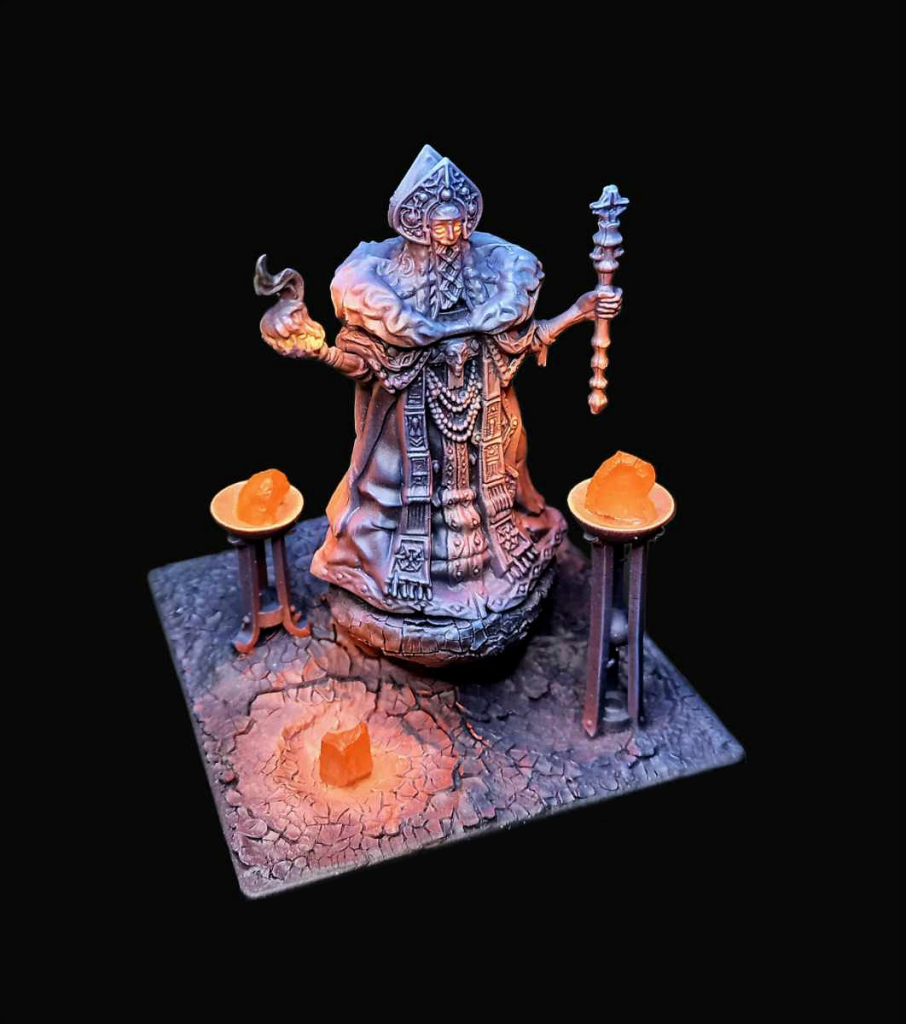
One of the most powerful spellcasters in the game, an Archimandrite comes in the original Old Dominion starter box and will feature in many lists. Although they can’t reach the pure destructive potential of a Dweghom tempered fire sorcerer, or heal as much as a 100 Kingdoms Water Mage, no other spellcaster in the game combines such high spellcasting values with such a variety of offensive, buffing and healing spells to select from. No matter where they go in your initiative stack or what’s going on around them, an Archimandrite will always have something powerful to do with their spellcasting.
Archimandrites are also a primary source of payoff for reaching higher Dark Power tiers. Their powerful healing spell Hazlia’s Touch scales directly with the tier of Dark Power, and become very powerful as the game progresses, and in a list that can reach Dark Power Tier 4 can heal 5 wounds per successful cast. This is a big payoff if you can carry your fragile priest into the late-game – five wounds might still be less than healers in other factions can spike, but not all wounds are created equal. Restoring an entire stand of Kanephors represents undoing much more of your opponent’s effort than the same amount of healing on a Hundred Kingdoms infantry unit by a Water Mage.
Sample Loadout:
Archimandrite, Unholy Mastery, Devoted to Hazlia, Consecrated Mitre: Weighing in at a pricey 190 points, this Archimandrite is premier spellcasting support. Able to reach a godlike Priest (10) or even Priest (11) in the right army, his spells will almost always succeed and he will usually be able to cast two spells per activation.
However, with most Archimandrite spells just need to successful cast, always remember you can easily get away with just a baseline 110pt Archimandrite.
Heirodeacon
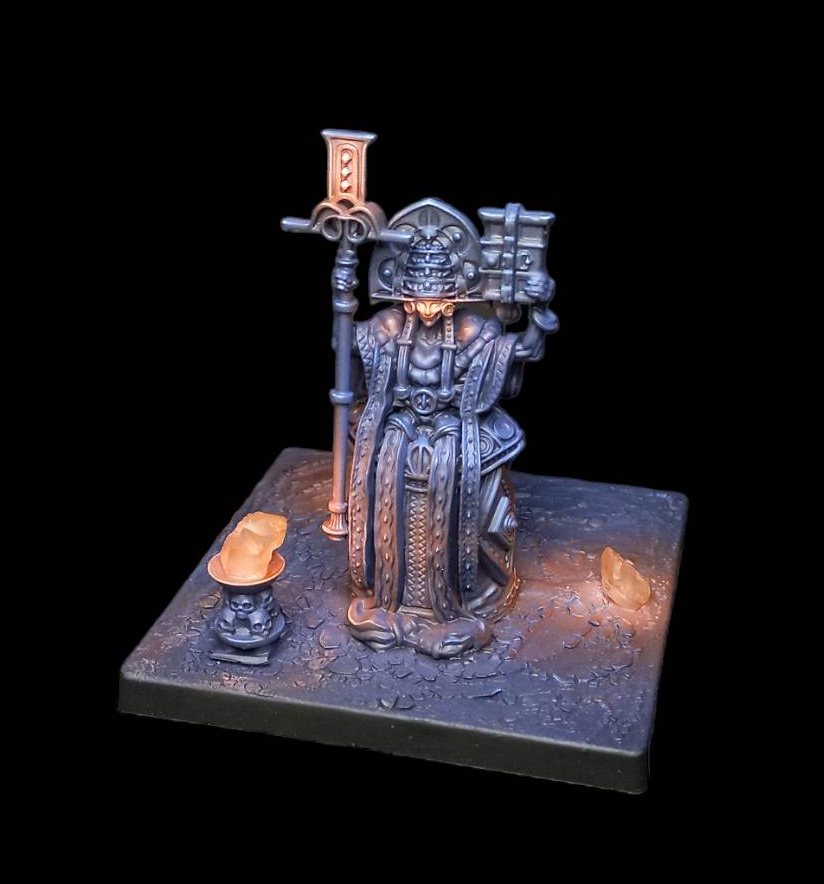
Our other spellcasting character, Heirodeacons are support spellcasters. Their Dark Supplication spell is one of only two ways in the entire faction to add Dark Power to the pool without sustaining casualties, and for this reason a Heirodeacon is almost always present in an Old Dominion list. The effect of this basic, no-frills Heirodeacon loadout can’t be understated – so long as it’s present, you will slowly be gaining more of the power that makes your army more powerful, which puts your opponent on a clock. You will be getting more powerful as time passes; they won’t.
One unique note about Heirodeacons is their offensive spell, Blackflame Coruscation, which is a passable offensive spell that doubles as a surprisingly strong payoff for getting Dark Power high (thanks to scoring additional hits equal to your Dark Power tier). This means Heirodeacons come with their own payoff, and it’s quite possible to run two Deacons in a list, functioning as their own setup and payoff – aiming to get you to the higher tiers quickly and become competent blasters when they do.
Finally, Heirodeacons have the Dark Shepherd ability, which lets you kill your own troops. In any other army this would be a bit of a head scratcher, but in Old Dominion it adds a potential additional source of Dark Power. Use it sparingly, but remember it exists – it can be especially useful in an early game if there’s an Archimandrite nearby to heal back a stand (albeit wounded) that a Heirodeacon destroyed. In a pinch, some games have even been won by a Heirodeacon topping their own unit (and themselves) at a pivotal moment to push the dark power pool a tier higher.
Sample loadout:
Heirodeacon, no upgrades: A simple and effective early game power battery and late-game blaster, the Heirodeacon really does not need any upgrades to do their job and should usually come in at just the basic 90pts.
Strategos (Mounted and on Foot)
Our first martial character, the Strategos comes in two varieties: mounted, and on foot. While sharing broadly similar warbands, the mounted Strategos has a clear focus as a cavalry commander, being both an excellent cavalry combatant personally, and able to take two Kataphrakt units as mainstays, making for a very flexible and easy to manage warband.
By comparison, the Foot Strategos is, at time of writing, back on the shelf after a year of absolute primacy. While mainstay Athanatoi are attractive, his combat stats are among the weakest of any melee character in the game, meaning he’s significantly eclipsed in the role by the Xiliarch. But as always, Conquest is a living ruleset, and everything has its time in the sun again soon enough.
In both cases, as a warlord, the Strategos’ supremacy ability is army-wide and has two components. The first is that it allows you to reach Dark Power Tier 4. This is a niche but useful ability, and while many effects in Old Dominion that scale directly with Dark Power Tier have been removed over time, being able to reach the extra-terrifying level is still a nice if very occasional benefit. More important is the Strategos Warlord’s activated ability, which gives every regiment in your army a free additional reform and allows you to treat your Dark Power Tier as one higher for a round.
This supremacy ability is both powerful and flexible, and can be used at a variety of stages through the game. The simplest application is as straightforward charge threat extension, as the free reforms can be used to rotate your regiments to move their corners much closer to the enemy, effectively giving you a significant charge extender. But free additional actions are always good, and I’ve reformed my way out of absolute logjam situations my opponents tried to put me in on many occasions with a well timed Glimmers of Golden Age.
Sample Loadout:
Mounted Strategos, Eternal Discipline, Aventine Armour, Skofnung: this Strategos turns a unit of Kataphraktoi into an astonishing anvil, provided they aren’t being targeted by extremely high cleave or armour piercing attacks. It’s also an ideal place for the very impressive Skofnung sword, with the goal being to bring the Kataphracts on late into a matchup where they can leverage its full power and win the game.
If you want a cheaper loadout, you can run the Mounted Strategos with just Eluthera, which makes him an able duellist and double-dips on the Clash bonus, as increasing his Clash also improves the accuracy of his impact attacks.
Xiliarch
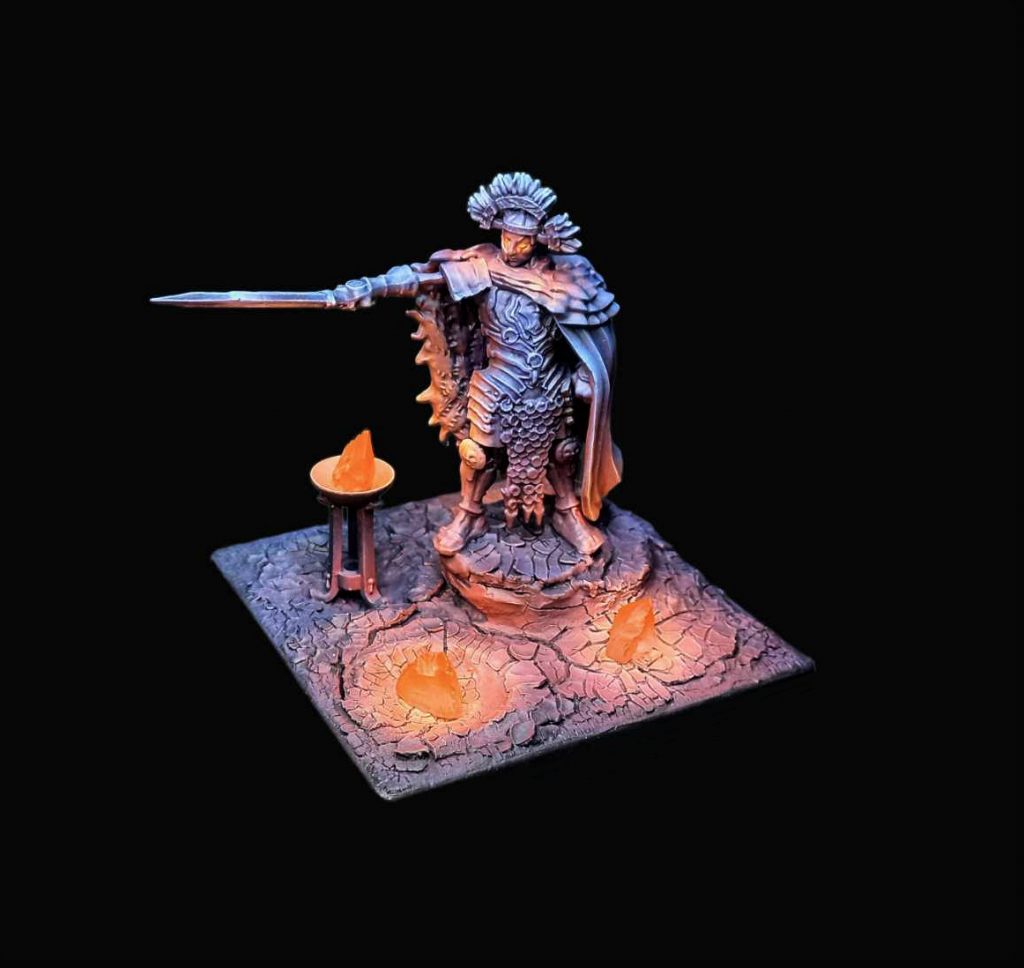
A dedicated Foot character, a Xiliarch adds no special rules to his regiment other than his own personal melee prowess, but that melee prowess is significant. One of the more dangerous baseline melee characters in the game right out the gate, the Xiliarch is a character who can vary from ‘dangerous’ to ‘extremely, stupidly dangerous’, and excels adding significant lethality to units that might otherwise try to wear down their enemy through attrition alone.
Where a Strategos’ supremacy ability is army wide, a Xiliarch’s focuses on their warband, giving every regiment in that warband an extra free clash action that round. Although this requires setup (you need to be able to get your units to combat and not have them die or be stalled out), it’s an intensely powerful effect, as the Xiliarch has a high quality warband and will be adding his own offensive power to one of those regiments.
Worth remembering is that this ability doesn’t just let you perform two clashes. It can also let you perform two other actions, then clash. In a pinch this means a unit could march + charge + clash for cavalry-level threat ranges from our infantry formations.
Sample Loadout:
Xiliarch, Calamitas, Blade of the Caelsor, Aventine Armour: clocking in at an eminently reasonable 145pts, this Xiliarch has 7 attacks at clash 3, cleave 2, and terror 1 with flurry. This Xiliarch can be parked in any unit to turn them into an existential threat to most enemies while also increasing their durability with the excellent Aventine Armour. This Xiliarch will generally sit inside a unit of Praetorian Guard, who are durable enough to ensure he gets where he needs to go and kills what he needs to kill.
Fallen Divinity
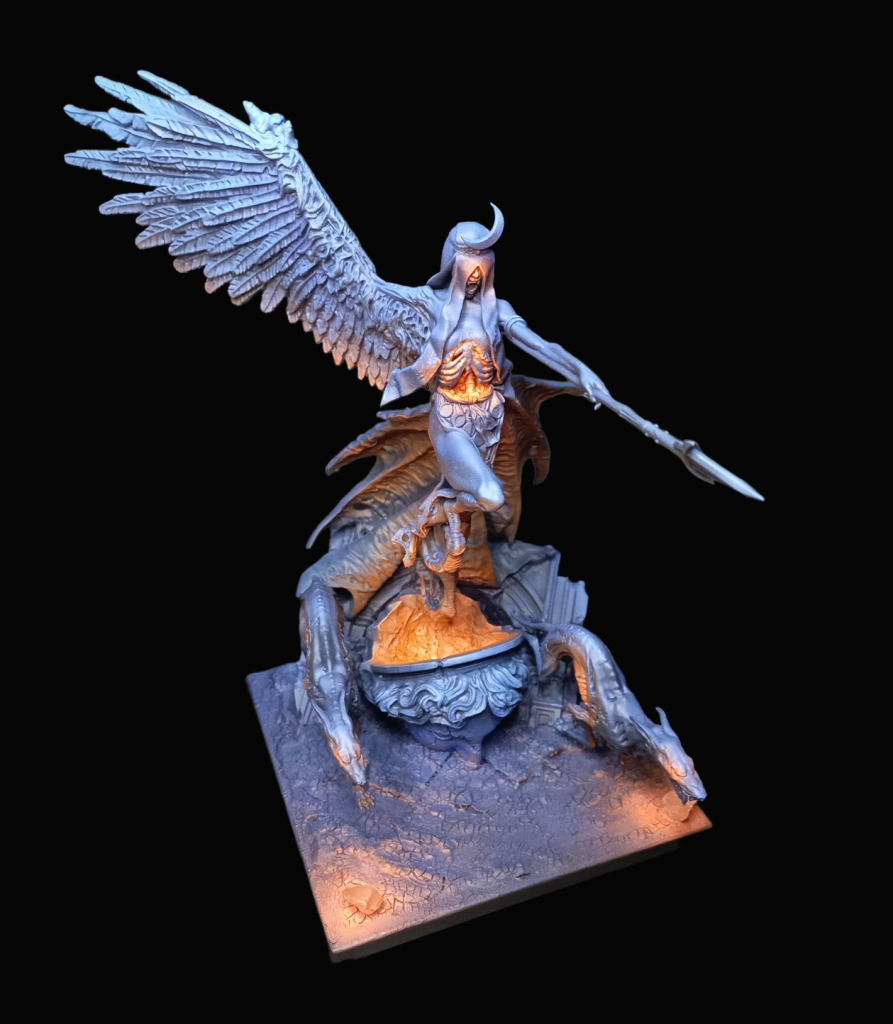
An incarnation of a fallen member of Hazlia’s Pantheon, the Fallen Divinities are horrifying dark gods – and effectively embody an entire variant to our usual army-wide special rules. As mentioned above, Dark Power normally gathers in a single dark power pool that then boosts the surviving models in the army (wherever they might be on the battlefield). When a Fallen Divinity is present, it instead gathers in her own Fallen Divinity pool. Rather than empowering the army, it instead empowers and heals her, boosting her own stats and allowing her to boost troops within a radius around her.
This radically changes how the army plays since it means your power is all concentrated in one place. A Fallen Divinity can be an intensely powerful element, but all that power occupies just one spot on the battlefield, which is almost impossible to oppose when fully online but offers your opponents a great deal of space to play where she isn’t.
When building lists around a Fallen Divinity, bear in mind that your army will almost never unlock memories of old as a draw event, and will certainly never reach the tier of dark power that makes them inspired all the time. As such, look for troops that don’t necessarily need their memories as much or are comfortable using their memories as actions, like Kanephora and Centaur Kerykes
It almost goes without saying that there isn’t a more powerful model in the army in terms of payoff for generating a lot of Dark Power. A Tier 3 Fallen Divinity is the most powerful single unit in the game (exceeded only by particularly colossal massed rank regiments or the very biggest monsters with riders, and often not even then) – ferociously resilient, hugely dangerous, and a signal that the game is about to end one way or another.
Sample Loadout:
Fallen Divinity, Aura of Dread, Eternal Discipline: a Fallen Divinity can’t take equipment and doesn’t really need much boosting, but the Aura of Dread when taken by her will also boost units around her, which is very powerful. Eternal Discipline adds a layer of defence against Magic and Ranged attacks, which you can’t use the Divinity’s Blessed rule on.
However, very much worth noting is that the Divinity can also be played without any upgrades at all. The upgrades above cost a whopping 70pts, and those points could also be used to beef up your other units to help disperse your force. The baseline 300pt Divinity is my personal preferred way to play her, and I think it performs better in competition play against opponents who understand how to play by fighting where she isn’t.
LIGHT REGIMENTS
Kheres
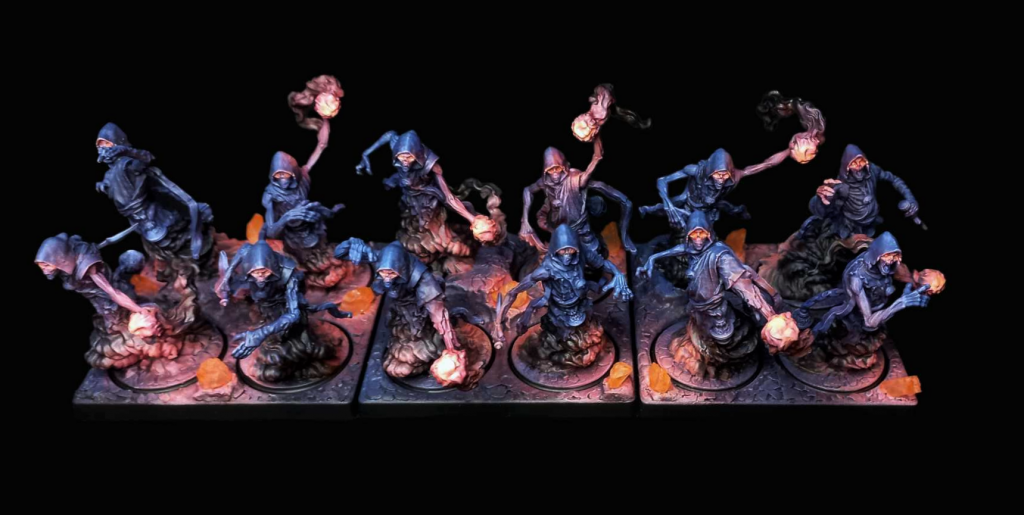
One of our two light ghost units, Kheres are a hybrid ranged/spellcaster unit who appear as a mainstay in the Archimandrite warband. They cannot have a character join them but supplement their light ranged poke with two unique spells, one of which they can cast every turn as a free additional action; Insanity (an offensive spell whose defence rolls are made against the lowest resolve in the target regiment, making it great at targeting high-defence, low-resolve targets) and Drain Will (a debuff which reduces an enemy regiment’s defence by 1 until round end).
Kheres are a fascinating unit that offer some unique capabilities that make them very attractive. In the history of conquest, I don’t believe there’s ever been a unit capable of taking three actions every turn that was bad, and Kheres are no exception to this trend. The fact their spellcasting is a free additional action makes them very flexible, able to provide support, ranged poke or even concentrate a little bit of damage if the circumstances are right. Although their ranged attack is among the weakest in the game, it’s still capable of causing some damage, and when that damage is added to the results of an Insanity spell, and their reasonable March of 6 and excellent Lose Formation rule is considered, they emerge as one of the better counter-skirmisher skirmisher units in the game.
This is a role that’s very valuable to the Old Dominion, as both early game pressure and enemy ranged attacks generally are some of the pressure points for this army. Kheres respond ably to both these threats, helping buy space and time for your army to come fully online. And as an animate vessel regiment themselves, their late-game threat shouldn’t be underestimated. I’ve had Kheres perform ably even in late-game melee situations, where they get free inspired on their melee attacks from Dark Power 3, and are able to perform action chains like Clash + Memories + massive spellcasting attacks to blow out regiments who tried to shut them down by March + Charging into melee.
Moroi
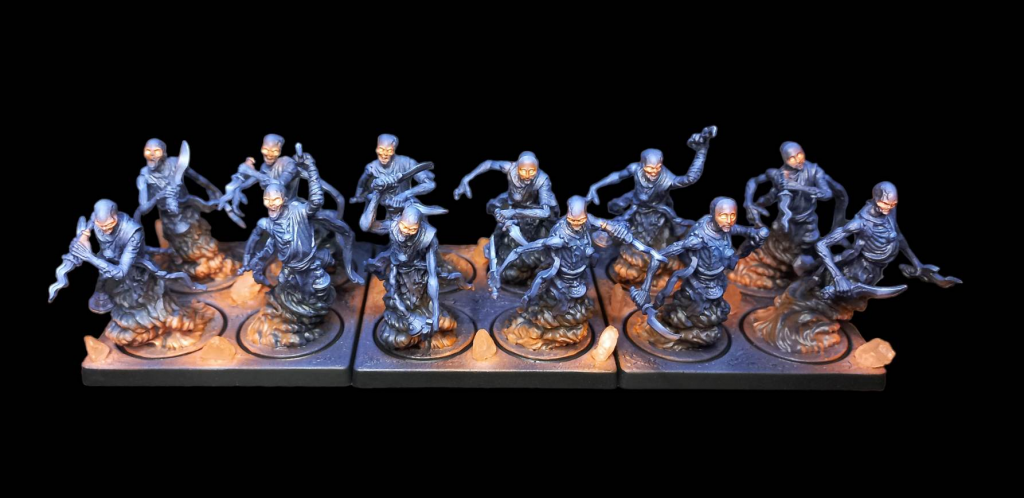
Our second loose formation light ghost unit, Moroi are likewise available only in an Archimandrite warband, but unlike Kheres are a restricted choice, and are a fast, fragile, dangerous melee unit rather than a ranged one. Combining high attacks, cleave (through memories of old), and aura of death, Moroi put out a lot of hits and are one of the more dangerous light units that exist in the game.
More importantly, they’re also insanely fast; march 6 is high by Old Dominion infantry standards, but more importantly they have their own free spellcasting actions just like the Kheres, and one of these spells is translocation, which teleports the regiment 8” and can then be chained into charges and clashes. This lets a small Moroi unit get 20” up the table on turn one, and opens up some truly eye-watering manoeuvrability provided they successful cast the spell each turn (which is likely, but never guaranteed).
This truly unparalleled speed makes the moroi one of the scariest disruption and predation units in the game, excelling in situations where they’re able to use their speed to get unopposed pick-offs of enemy units without being collapsed on themselves. Their worst nightmare is taking a fight that’s fair, because at 60pts a stand they’re made of absolute glass need to be treated accordingly. If you’re not comfortable managing a fragile speedster in Old Dominion, Bone Golems may be a better use of the restricted slot, but if you’re willing to make them work their potential is superlative.
Cultists
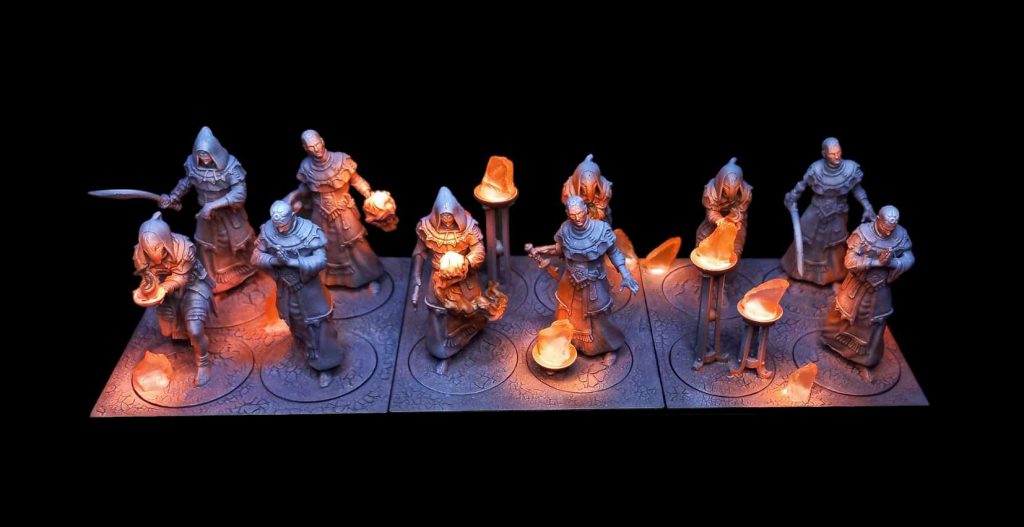
One of our living units, Cultists are a serviceable light ranged unit with the excellent Loose Formation rule (allowing them to be combined with Kheres and Moroi for an entire front line of early-game ranged-resistant troops). While their volley, range and defensive attributes aren’t exactly stellar, Cultists nevertheless have two major strengths. Firstly, they can be joined by a character, which means our Heirodeacons and Archimandrites can get on the table earlier, in relatively durable bunkers (if you can keep them out of melee). Secondly, they’re an exceptionally affordable 90pts, which for even a serviceable ranged unit is frankly a bargain. There are entire factions that would commit unspeakable acts for a mainstay this accessible.
While Cultists aren’t animate vessels and therefore don’t generate much dark power when they die (only providing a single dark power when the unit’s command stand is destroyed), don’t let that prevent you from taking them, especially as an escort for something like a Heirodeacon. The old adage about a bird in the hand being worth two in the bush applies in full here – yes, the cultists are worth fewer dark power in total than a unit of legionnaires would if it got wiped out, but you aren’t usually planning on getting your units wiped out, and your Heirodeacon will be generating power from the turn she turns up.
Hashashin
Although the bulk of the Old Dominion roster is in a relatively strong place, with very few regiments that don’t have a use case in at least one build, Hashashin are the current sole exception. They are essentially much slower, less durable Moroi for the same price point, and while their damage output with both cleave and deadly blades (not gated behind Memories of Old) is appreciable, they simply don’t play into the Old Dominon game plan, or add something unique to the faction, in a way that Cultists do.
MEDIUM REGIMENTS
Legionnaires
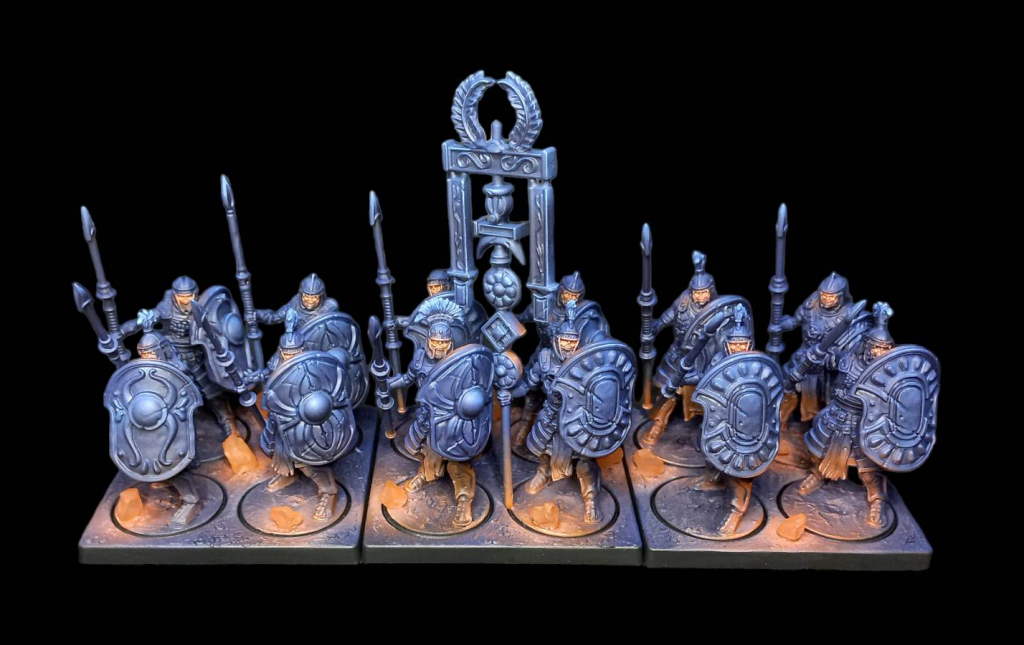
Legionnaires are our most common mainstay regiment (equivalent to Bound Clones, Men at Arms, Hold Warriors etc), present in nearly every warband except the Fallen Divinity and often the easiest way to bring a scoring unit that unlocks restricted options for your army.
The best way to think of Legionnaires is as small-squad auxiliaries and not actually anything like the kind of classic image of a Legion we that we might have absorbed from Asterisk and Obelisk comics growing up. Legionnaires are meaningful in small units only, but they’re excellent in that role. While their stats are mediocre-to-bad across the board, that doesn’t matter in the slightest as they’re extremely cheap at 100pts for a mainstay scoring unit, and being animate vessels gives them a level of baseline durability that helps them survive non-committal attacks despite their relatively anaemic defences.
Their low cost, in combination with their Memories of Old which increases their scoring weight, makes them both ideal generalist scoring units and especially great units for baiting out disproportional responses. They can’t fight their way out of a moderately wet paper bag, but if you place them within 12” of a zone, you threaten the ability to rush a significant weight of scoring onto that zone. This forces your opponent to either commit significant weight of their own to holding the objective, or divert forces to both scoring and pursuing the legionnaires – all of which is guaranteed to require significantly more than the 100pts the legionnaires costs, which means your own forces elsewhere on the table are likely to have advantages in their own engagements.
Praetorian Guard

Elite versions of legionnaires (and built from the same kit), Praetorians give up Support (2) and accept a tolerable increase in cost to otherwise improve on legionnaires in every way. They’re a little more dangerous with 5 attacks per stand, but more importantly they’re much more durable – the extra wound and extra defence go a huge way in making the unit able to perform as a very serviceable anvil, and although they clock in at a relatively pricey 160pts for a base unit, at only 45pts per additional stand, they scale up reasonably well. You’re paying for durability, but durability at that cost is efficient, and sets up a big, useful unit that can anchor a battle line, or serve as a home to a powerful character. In essence, any time you’re thinking about adding stands to a Legionnaire unit to make it durable enough to actually take a fight, you should consider taking Praetorian Guard instead. Because they’re a natural home to a powerful combat character like a Xiliarch, they’re also a unit that you’re often willing to activate early during a turn when the lines have met, maximising the chance that they’ll be able to make use of their Bastion.
The biggest impediment to fielding Praetorians is that they’re only a mainstay regiment for the Xiliarch, meaning that’s where you’ll most commonly see them. Easily the most common configuration for them is in a 4-5 strong unit as an escort for either a combat capable or Xilliarch, who provides killing power of some description to complement the Praetorian’s durability. It’s an expensive combination, probably coming in at close to a quarter of your army much of the time, but it’s a potent concentration of force, and concentration of force destroys armies.
In a pinch, an Archimandrite might also give up a restricted slot for some Praetorians to hide in, hoping to make use of his presence in a more aggressive frontline regiment. Some Archimandrite builds can get very pricey but very dangerous, and the extra durability of Praetorians as a bunker can be well worth the investment.
Kataphraktoi
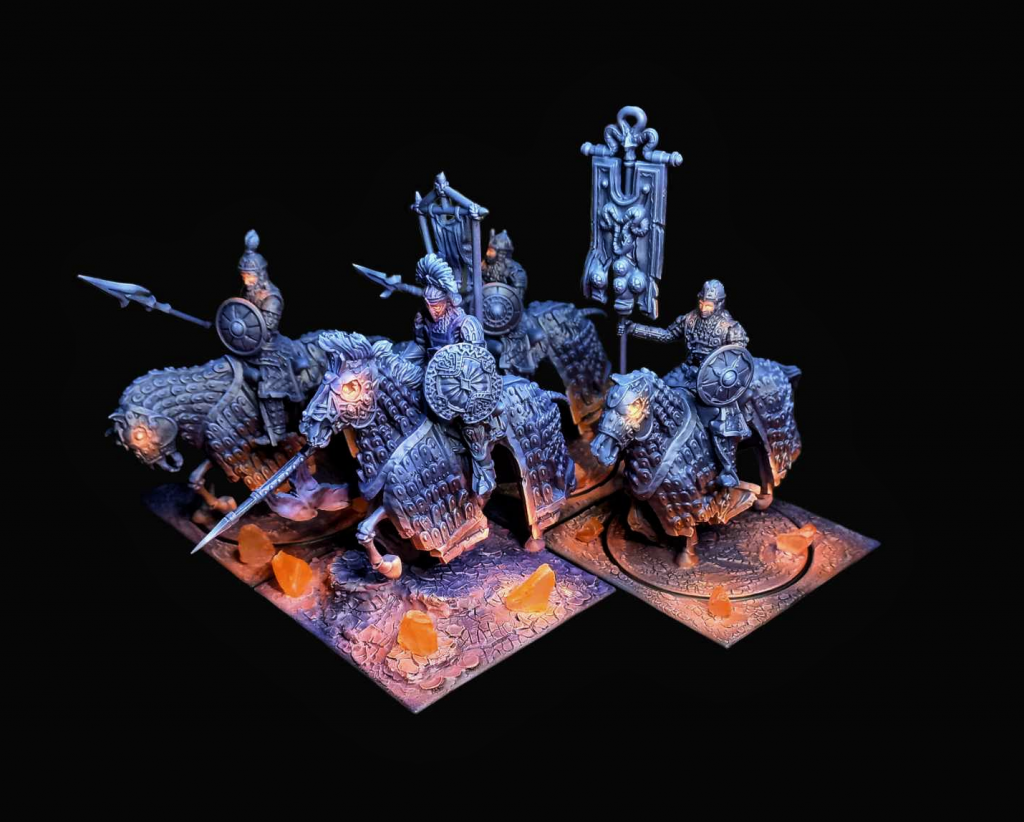
The Old Dominion’s shock cavalry (they even have the ‘shock’ rule), Kataphraktoi are some of the game’s pre-eminent impact attack regiments, packing a high number of impact attacks, brutal impact, terror and a serviceable clash value on the charge.
On paper, Kataphraktoi are tougher but less dangerous equivalents to the Hundred Kingdom signature Crimson Tower heavy cavalry, with highly similar attributes across the board. Crimson Tower outperform Kataphrakts offensively both on the charge thanks to their Wedge! rule and in a sustained fight thanks to their higher native clash value, but are less resilient thanks to taking resolve checks (albeit at a high native resolve of 4).
You would think that the bias toward offensive power in an assault cavalry unit would make Crimson Tower the better of the two units, but the real difference between the two units emerges when you consider the context of their faction. Assault cavalry regiments in in Conquest rarely want to be first into the fray, hitting the enemy square and in the front of a prepared defence with a counter-assault waiting in the wings. Instead, cavalry like Crimson Tower and Kataphrakts are second-wave units, appearing to counter-charge enemies pinned in place by durable or expendable infantry elements.
And this is where Kataphraktoi shine – as the hammer to the rest of the faction’s anvil. Old Dominion are nothing but anvils, with every unit in the army always liable to take just a little longer to kill than your opponent plans, always a little too durable to blow through easily and engineer a breakthrough against. And in that environment, despite being less optimised profiles than Crimson Tower, Kataphraktoi shine.
On top of that, should they need to fight in a sustained melee, the durability of Kataphraktoi means they still have fundamentally solid stats for force multiplication by both a mounted Strategos and support spellcasting from an Archimandrite. Skofnung is strong as they have a solid volume of attacks; Eternal Discipline and Aventine Armour are great on them as they are our only natively Defence 4 unit. And because they get their resilience from their defence rather than their wound count, healing from an Archimandrite is comparably more efficient than trying to heal a unit with more wounds but worse defense.
(I realise here that what I’ve said is “if you give this regiment Linebreaker, Untouchable and Hardened, they’re really good”, which is a statement that can be made of any Infantry or Cavalry unit in the Old Dominion roster, but they are still a solid if pricey vehicle for attaching a character to.)
Ultimately, you don’t want Kataphrakts bogged down in a sustained melee, and you especially don’t want them going multiple rounds against anything with even moderate cleave values, but like any old dominion unit, if you need to grind, they can.
Karyatids

Our premium ranged unit, Karyatids are brutes wielding greatbows in the style of Byzantine Ushabti. Although they don’t outrange the longest-ranged ranged units in the game (longbows and marksman clones can fire further, for example), they have the longest range of any Armour Piercing 2 unit and an impressive Barrage of 4 per unit once their memories of old are active as a draw event. They also serve as an able counter-battery unit thanks to their defence of 3, which is high enough to offer some protection against more regular enemy ranged units armed with bows or crossbows. As a brute unit, they’re also tall enough to shoot over our infantry, making them very flexible in terms of the support fire they can provide.
Ultimately, the only reason not to include Karyatids in most lists (apart from the fact that they are often a restricted unit) is that as a ranged unit they fundamentally fill a support role, not a mainline combat one. In Conquest as with most wargames, you don’t want to build your armies with too many support elements and not enough units to do the actual heavy lifting. And because our characters are so strong, we often spend a lot of our nominal ‘support budget’ on them. A Karyatid presence in your lists will almost always be good, but make sure to balance them against your characters and ensure you still have enough meat and potatoes in the list to do the fighting and the dying on the front lines.
Athanatoi
As Praetorians are more expensive, much tougher Legionnaires, Athanatoi are more expensive, much blendier ones. About as durable as regular legionnaires at native Defence 2 (although Tenacious goes a huge way in propping them up against chip damage) but far, far more dangerous on a per-stand basis thanks to a whopping 6 attacks with flurry, Athanatoi are a unit only available to Xiliarchs and Strategos but are an interesting choice in both.
Since the most recent update, Athanatoi have stepped up as a truly viable combat unit, and a choice you can make any time you want a medium blender unit that puts out an impressive amount of damage relative to its footprint and even scales up into larger units ok thanks to its relatively cheap cost-per-stand, Athanatoi are a solid inclusion in any Old Dominion force. They can be added as viable minimum-sized units where their damage output and Tenacious rule let them excel at taking fights against other small units, or as medium-sized blocks where their cheap cost per additional stand lets them add just a bit of extra resilience at a reasonable price. They can be fielded as mainstay units in any list with a Strategos, and can even be worth the restricted slots in a Xiliarch warlord list aiming to use his supremacy ability aggressively and early.
Centaur Kerykes
Centaur Kerykes are very similar to Karyatids and even appear in the same warbands (albeit as mainstay with a Heirodeacon). They’re faster but with lower range, about as dangerous per shot but with fewer shots, nearly as tough and with access to the very situational but sometimes very useful Sureshoot rule. They are, however, cheaper than Karyatids, and I recommend them in particular in Fallen Divinity lists, where neither unit can rely on its memories of old, which hurts the Karyatids much more than the Kerykes.
Otherwise, everything I said about the Karyatids applies to the Kerykes – they’re a little different, and a little cheaper, but appear in the same warbands and fulfill the same role. Take Kerykes when you’re desperate for the mainstay units to unlock restricted units, and take Karyatids when you’ve got the restricted slots free.
Profane Sepulchre
When I first reviewed the Profane Sepulchre following its 2.0 rules update, I made the claim that there was no way the model was balanced, but that I had no idea if it was too powerful, or not powerful enough. Since then, a balance pass has removed the ability of the Sepulchre to theoretically trade its entire wound stack for one omega nuke, and I’ve had the opportunity to to actually sit down and play a game with it (the only model I had never fielded or proxied since the 2.0 update to the game) and honestly – I’m still not quite sure how I feel. But I have a better understanding of the profile.
How the Sepulchre works at a fundamental level is as a big, chunky, but offensively anaemic model trades its massive wounds pool for a variety of effects. The challenge here is that the effect of the Exhortations of Eternal Faith will almost always do fewer wounds to the enemy than they do to the Sepulchre, but Sepulchre is built specifically to trade wounds inequitably like this – for its cost, it’s has a huge wound pool, and is among the chunkiest unit in the entire game (even a Tontorr is less durable).
Ultimately, however, despite having paragraphs and paragraphs of rules to trade on, the biggest challenge posed to the Sepulchre is that most of its effects are not actually particularly compelling, particularly given the ‘cost’ they represent. Since the Profane Sepulchre costs 270pts and has 36 wounds, each wound costs 7.5 points. Since it can’t be healed, those wounds are all you get, meaning you can accurately cost every use of its abilities. Giving another regiment Dark Power 3, or boosting its own melee, costs you 45pts. Increasing the attacks of nearby command stands costs you 30pts. And dropping the big bomb costs you up to 90pts.
When you break it down this way, it’s hard not to conclude that these are steep costs for single-use effects. Compare spending 30pts to give +2 attacks to command stands within 12”, to the Dweghom Remembrance of the Core, a single-use item which gives +1 attack to every command stand in the army regardless of range for one round, and costs only 10pts.
In the one game I’ve played with the Sepulchre, I built the army to try to be able to use all of the possible Exhortations over the course of the game, but instead spent thirty-five wounds causing hits to the enemy over three rounds, then running off to an objective (well, waddling off to an objective) for the last few rounds. It took some lining up but I was able to land very close to ideal hits on all three bombs, and… it was pretty ok? It almost certainly did less sustained damage over the course of a game than a unit of Karyatids would, and it also didn’t ‘pay’ for itself (but this is a bad metric by which to measure the success of a unit) – but it dealt some big bursts of explosive power in specific places at times that really mattered, contributing to the shattering of an enemy unit in one case and blowing out an enemy aura of death unit before one of my units had to engage in another. These were high impact effects that were less susceptible to the vagaries of dice, range or line of fire than a normal ranged attack would be, and which can’t be stopped by just running to engage a unit like Karyatids would be.
At a hunch, I don’t think this was the experience the designers were going for. It’s an interesting effect, and a powerful one (albeit at a premium, given the points cost), but there are so many sentences of rules that can mostly be glossed over in terms of actual use case. The Sepulchre isn’t bad, but I also wouldn’t be surprised if we see another rules pass on it before it sees model release.
HEAVY REGIMENTS
Bone Golems
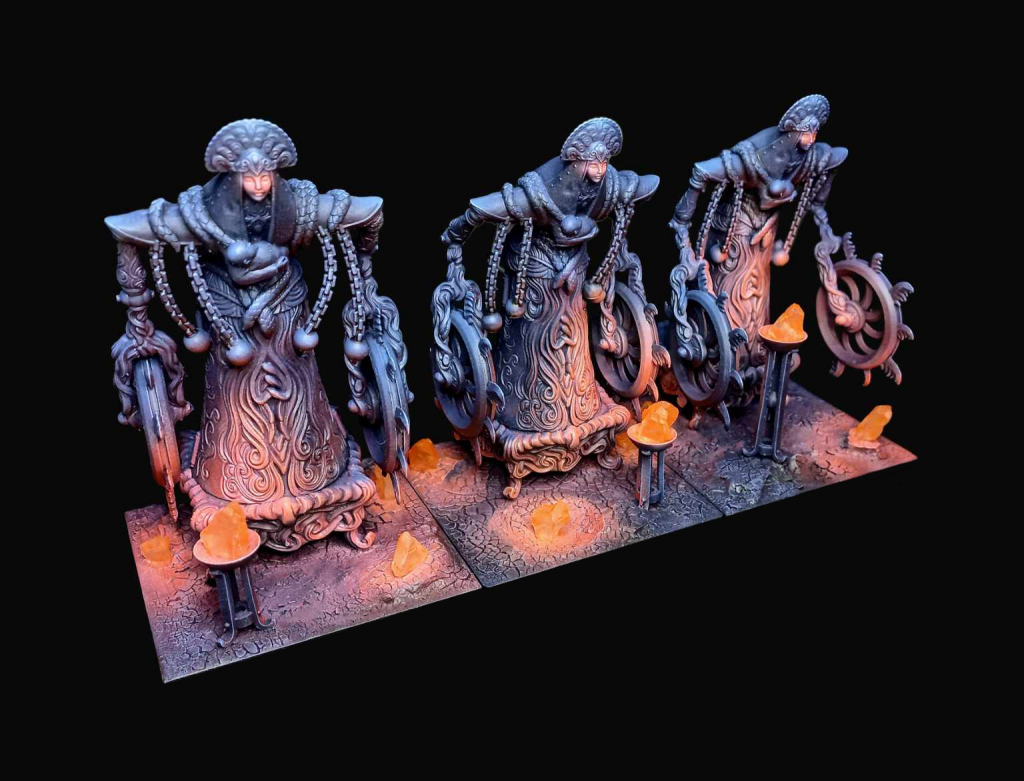
Let me open this section by saying: the Old Dominion has no bad heavy units. All our heavies are good, and the way Old Dominion plays with an emphasis on getting stronger over time and keeping our eye on the late game means that heavy regiments play perfectly into our game plan. Not every list can or should be ‘all heavies all the time’ (if nothing else, the scenario challenges posed to such a list are very real), but our heavies – Bone Golems included – are good.
Bone Golems are strong, fast, and durable. The closest thing they have to a drawback is the degree of randomness in their attacks (being Clash 2 with Relentless Blows is mathematically equivalent to being Clash 3, but in practice it means you’ll have a lot more peaks and valleys in your attacks), but they make up for that by being consistently durable, able to reroll charges, and having a powerful Aura of Death.
The Aura of Death in particular makes them very useful into almost all targets, since it means they’re layering their Cleave 2 primary attacks with both Impact Hits and Aura of Death hits. This means they’re able to deal with both heavily armoured regiments and lightly armoured regiments you want a lot of hits to chew through. You’ll never go wrong including Bone Golems, and they’re the main reason the restricted slots in an Archimandrite warband are so heavily contested.
Kanephors
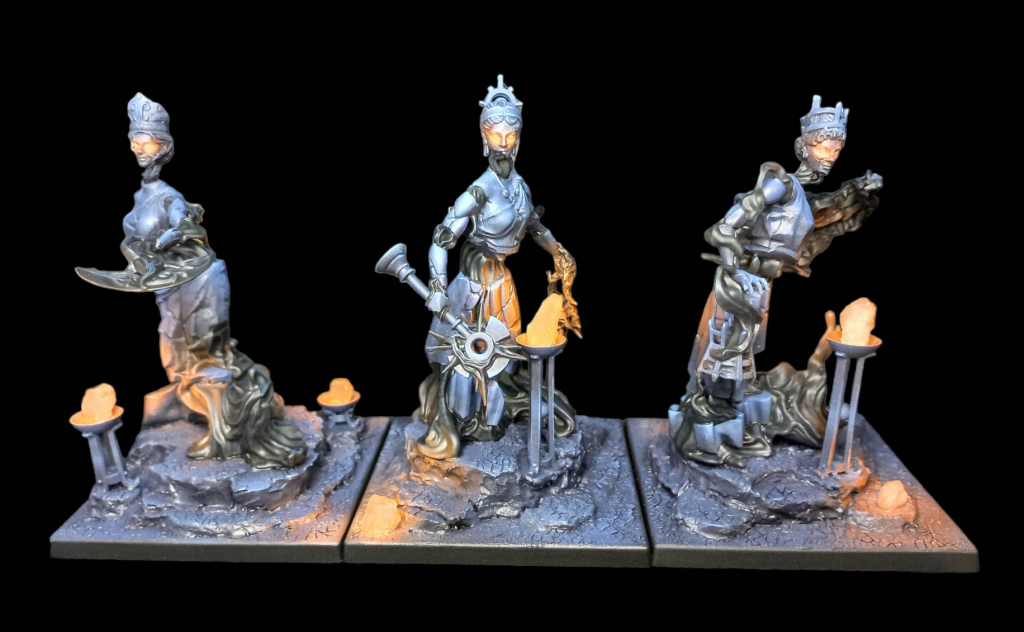
Our second currently released melee heavy Brute, Kanephors combine a series of rules (blessed, flawless strikes, hardened + good evasion and generally good stats across the board) to produce a unit that has no enemy it particularly excels into but also no enemy that particularly excels into them. Within reason, they can be relied upon to plug almost any gap in your lines, and engage and do ok against almost any enemy.
Since they’re heavy and will arrive later in the game, this makes them a perfect emergency response unit. If your opponent is directing overwhelming force at some part of your line, Kanephors can move in to hold that position and will probably account well for themselves in a way that Bone Golems for example might not if confronted by, say, Cleave 3 Fiend Hunting Dragonslayers.
As with every Blessed unit, the biggest weakness of Kanephors is being exposed to multiple high quality attacks per round. Watch out for particularly dangerous ranged attacks being directed at them in the same turn as you send them into the breach against a high-powered enemy melee unit. Even they have limits, and that much force split across multiple attacks will test it.
Varangian Guard
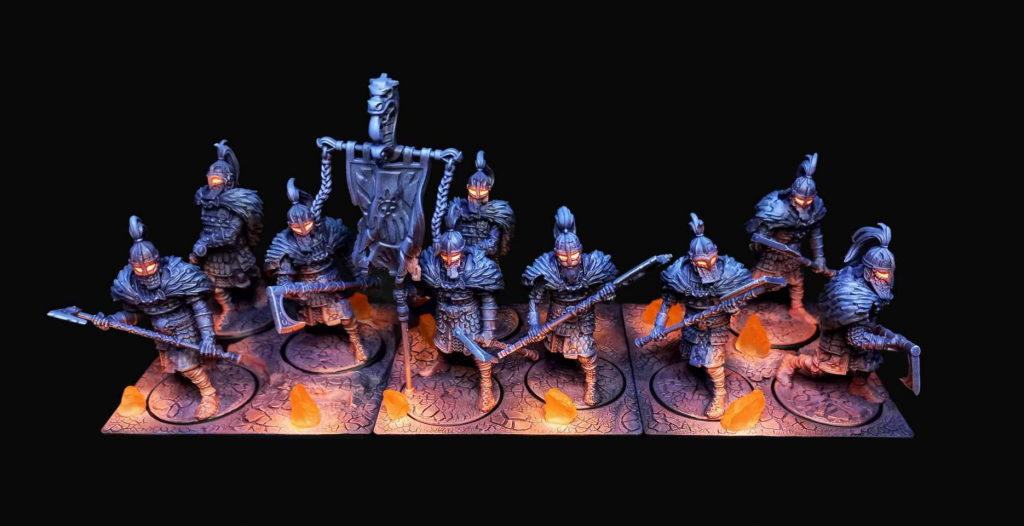
Our only non-brute Heavy regiment, Varangian Guard are elite can-opener infantry. Only available in a Xiliarch warband, they alone would be payoff for his inclusion if a Xiliarch didn’t already, you know, absolutely slap.
Although they’re technically the most fragile of our heavy regiments, defensively they’re still no slouch, being animate vessels with 5 wounds, Defence 3 and Hardened 1. On top of that they have a respectable Clash 3 and with their memories of old are able to climb as Cleave 4 with Linebreaker. Nothing without evasion shrugs that off – even Steelforged are saving on 1s. And while they might only have four attacks per stand and cost an expensive 200pts for the initial regiment, being relatively cheap to add stands to means that a regiment of four Varangian guard stands dishes out 17 attacks per clash and ‘only’ comes in at an expensive but affordable 265pts if you pay for a standard (which you should).
On top of that, being in the Xiliarch’s warband makes them eligible for the Xiliarch’s supremacy ability, making them the ultimate payoff for a Xiliarch warlord. Varangian Guard are very nearly Dragonslayers (albeit cheaper and usually a little less dangerous most of the time), but when they can clash twice in a turn, they’re just about the high watermark for offensive damage out of a single melee unit in the game.
Buccephaloi
Our third and final heavy Brute regiment, Buccephaloi are undead minotaurs, and with the most recent design update, have finally slotted into their own unique niche, which is “Heavy Regiment That Doesn’t Cost 210 points”.
While that sounds like they’re being damned with faint praise, you genuinely get a solid suite of unique upgrades over their competitors for the extra price premium, which makes Buccephaloi an extremely valuable option to have available to us. They’re a generally well-rounded profile, with the same clash, attack and cleave values as Varangian Guard but with a meaningful set of impact attacks (which makes a big deal if a charge + clash connects, and is particularly useful for destroying objectives), good survivability with 6 wounds, Defence 3/Evasion 2 and the always-useful Tenacious special rule, and solid melee threat ranges with March 6 and unstoppable. They also come with a bit of extra quality of life in the form of the Devout rule, which makes healing them with Archimandrites or giving them Blessed with Heirodeacons very easy.
These rules make them generally well-rounded and particularly good as a hammer unit if something else holds the enemy in in place, but with enough durability to also benefit well from spellcasting supporting or hold up in a brawl if needed. Buccephaloi find their way into my lists any time I have 10pts spare to upgrade Kanephors, and find their way back out again in lists when I’ve got absolutely no other way to shave 10pts from a list. That kind of flexibility is very nice, and only becoming more so as faction updates see small niche unit and character upgrades removed in favour of a smaller number of big-ticket items.
Their models are also absolute bangers, which makes including at least one regiment an attractive choice in the literal sense.
STARTING YOUR OLD DOMINION COLLECTION
Starter Army – 1,000pts:
== (Warlord) Archimandrite [110]:
* Legionnaires (3) [100]: Standard Bearer
* Kheres (3) [160]:
* Bone Golems (3) [210]:
* Bone Golems (3) [210]:
== Hierodeacon [105]: Devoted to Hazlia
* Legionnaires (3) [100]: Standard Bearer
This list is built almost entirely from the Old Dominion 5th Edition army starter box, with the only addition being a single Heirodeacon to allow us maximal use of our regiments and get us up to just about 1,000 points.
While this list isn’t exactly well-rounded (pretty much all the power is concentrated in the Bone Golems, and you don’t want to be taking melee fights with those legionnaire units if you can avoid it), it includes a core dark power acceleration package as the Heirodeacon sacrifices stands from regiments and the Archimandrite heals them right back. It’s also, as far as these things go, an affordable entry point into the game, costing $185 euros before any shipping or discounts (like the Goonhammer discount code, which you can find a link and code for at the end of the article).
If you’re looking to expand this list to 2,000pts, you have several very good options for directions to take it. Expanding the Heirodeacon’s warband is a safe choice, with Cultists as a cheap mainstay to get her onto the field earlier and unlock some of her excellent restricted choices, like Kanephors or Buccephaloi (or both). From there, you’ll want to pick a third warband to bring you up to 2,000. A Xiliarch or Mounted Strategos would both make excellent alternate warlords to the Archimandrite and bring very capable warbands that can bulk out the strength of your medium regiments with things like Athanatoi, Kataphrakts, Centaur Prodromoi and Praetorian Guard. Finally, you could also consider a Fallen Divinity – there was a time when she was hard to use with an Archimandrite, but now that Kheres can spare an action most turns to activate their memories of old manually, you can build an excellent Divinity list that focuses on lots of light and lots of heavy regiments with very few mediums.
Here’s an example of how you might build the list out using a Mounted Strategos:
Cavalry Expansion – 2,000pts:
== (Warlord) Mounted Strategos [170]: Aventine Armor, Calamitas, Blade of the Caelesor, Gladiator
* Kataphraktoi (3) [210]: Standard Bearer
* Athanatoi (3) [170]:
* Athanatoi (3) [170]:
== Archimandrite [110]:
* Kheres (3) [160]:
* Legionnaires (3) [100]:
* Bone Golems (3) [210]:
* Bone Golems (3) [210]:
== Hierodeacon [90]:
* Cultists (3) [90]:
* Legionnaires (3) [100]:
* Kanephors (3) [210]:
This list is running quite ‘wide’ with 13 activations, which might be challenging for some newer players to run, but makes the most use possible of individual boxes (i.e. it doesn’t require purchasing any boxes just to add one or two stands to regiments). If you find you’re struggling with playing this many cards in your stack, you can always combine units like the Athanatoi and Bone Golems together and use the points you free up to get an upgrade on your priest characters. There’s no downside to playing wide, though, and the high activation count can help make decisive use of your Kataphraktoi by letting them wait deep into the turn before launching a decisive charge.
As always if you want to get 10% off and support Goonhammer you can make your Conquest purchase by clicking here for US/Canada or here for EU/rest of world. You’ll also need to enter code “goonhammer” at checkout.
Have any questions or feedback? Drop us a note in the comments below or email us at contact@goonhammer.com.
